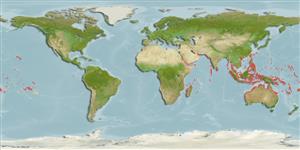Common names from other countries
>
Ovalentaria/misc (Various families in series Ovalentaria) >
Pomacentridae (Damselfishes) > Glyphisodontinae
Etymology: Abudefduf: Arabic, abu = father; this fish is the leader of the reef against other species (Ref. 45335).
More on author: Forsskål.
Environment: milieu / climate zone / εύρος βάθους / distribution range
Οικολογία
Θαλασσινό(ά); Υφάλμυρο Υφαλόφιλο(α); μη μεταναστευτικό(ά); εύρος βάθους 0 - 3 m (Ref. 4391). Tropical; 27°N - 37°S, 49°W - 126°W (Ref. 56028)
Indo-Pacific: Red Sea and East Africa to the Hawaiian and Pitcairn islands, north to Japan, south to Australia.
Μέγεθος / Βάρος / Age
Γεννητική Ωρίμανση: Lm ? range ? - ? cm
Max length : 24.0 cm TL αρσενικό/απροσδιόριστο; (Ref. 90102)
Short description
Κλείδες προσδιορισμού | Μορφολογία | Μορφομετρία
Ραχιαίες άκανθες (συνολικά) : 13; Μαλακές ραχιαίες ακτίνες (συνολικά) : 14 - 16; Εδρικές άκανθες: 2; Μαλακές εδρικές ακτίνες: 14 - 15.
Body shape (shape guide): short and / or deep; Cross section: compressed.
Inhabit rocky lagoons, reef flat shorelines and piers subject to mild surge; juveniles are common in tide pools (Ref. 9710). Benthopelagic (Ref. 58302). Occasionally form schools. Feed on algae, crustaceans and other invertebrates during the day. Oviparous, distinct pairing during breeding (Ref. 205). Eggs are demersal and adhere to the substrate (Ref. 205). Males guard and aerate the eggs (Ref. 205). Highly territorial (Ref. 9710). Utilized as a food fish by the Hawaiians (Ref. 7364).
Life cycle and mating behavior
Γεννητική Ωρίμανση | Αναπαραγωγή | Γεννοβολία | Αβγά | Γονιμότητα | Προνύμφες
Oviparous, distinct pairing during breeding (Ref. 205). Eggs are demersal and adhere to the substrate (Ref. 205). Males guard and aerate the eggs (Ref. 205).
Allen, G.R., 1991. Damselfishes of the world. Mergus Publishers, Melle, Germany. 271 p. (Ref. 7247)
IUCN Red List Status (Ref. 130435: Version 2025-1)
Threat to humans
Harmless
Human uses
αλιεία: περιορισμένης εμπορικότητας; Ενυδρείο: Εμπορικό(ά)
Εργαλεία
Special reports
Download XML
Διαδικτυακές πηγές
Estimates based on models
Preferred temperature (Αναφ.
123201): 24.7 - 29.3, mean 28.4 °C (based on 2750 cells).
Phylogenetic diversity index (Αναφ.
82804): PD
50 = 0.5000 [Uniqueness, from 0.5 = low to 2.0 = high].
Bayesian length-weight: a=0.02455 (0.01335 - 0.04514), b=3.11 (2.95 - 3.27), in cm total length, based on LWR estimates for this species & Genus-body shape (Ref.
93245).
Τροφικό Επίπεδο (Αναφ.
69278): 2.9 ±0.0 se; based on diet studies.
Ελαστικότητα (Αναφ.
120179): Μεσαίο(α), ελάχιστος χρόνος για διπλασιασμό πληθυσμού 1,4 - 4,4 έτη (Preliminary K or Fecundity.).
Fishing Vulnerability (Ref.
59153): Low vulnerability (14 of 100).
🛈
Nutrients (Ref.
124155): Calcium = 71.2 [35.8, 112.8] mg/100g; Iron = 0.593 [0.351, 1.034] mg/100g; Protein = 18.8 [17.6, 19.9] %; Omega3 = 0.0879 [, ] g/100g; Selenium = 16.2 [8.3, 31.9] μg/100g; VitaminA = 69.8 [19.2, 240.5] μg/100g; Zinc = 1.69 [1.12, 2.56] mg/100g (wet weight);
